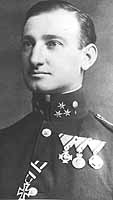Otto Jindra
Otto Jindra (born March 18, 1896 in Chlum u Třeboně , Kingdom of Bohemia; † May 2, 1932 in Prague , Czechoslovakia) was an officer and military pilot of the Austro-Hungarian aviation troops of Austria-Hungary in World War I. He achieved nine aerial victories as an observer . Jindra was also considered an excellent commander and coordinator. After the World War and the end of the Danube Monarchy, Jindra was an essential promoter for the creation of a Czechoslovak air force, which later came under his command.
Life
Jindra graduated from the kuk artillery shooting school in Vienna in 1905 and was initially assigned to the 14th Mountain Artillery Regiment . In December 1912 he was promoted to first lieutenant . With the outbreak of World War I, Jindra served as battery chief and regimental adjutant, where he was baptized by fire in the Battle of Lviv on the Eastern Front . For this he received the Bronze Military Merit Medal.
Shortly afterwards, Jindra applied for a transfer to the young aviation force. After approval of this application, he was transferred to Fliegerkompanie 1 (Flik 1) as an observer on September 10, 1914 . Jindra soon qualified as an accomplished observation officer who steered his own artillery with the help of the radio developed by Benno Fiala von Fernbrugg . On November 14, 1914, the Jindras aircraft and its pilot were riddled by Russian cavalry salvos and forced to land. 180 bullet holes were counted in the wreck before they picked up their belongings and fled home. At the end of January 1915, the commanding officer of Flik 1 was taken prisoner. Although he was not a pilot, Jindra was put in command in his place.
On June 13, 1915, the aircraft of its pilot Max Libano, an Albatros BI , was attacked by two Russian Morane-Saulnier monoplane . However, they managed to bring the attackers to the ground with their personal weapons, a pistol and a carbine . On August 27, Jindra achieved another aerial victory. On September 1, Jindra was promoted to captain . A little later, Jindra trained as a pilot himself, took his field pilot exams on December 11, and received his pilot's badge on December 20, 1915.
On January 5, 1916, Jindra had his first aerial combat as a pilot. He was slightly wounded and had to make an emergency landing because his fuel tank had been shot at. On March 29th he achieved his first aerial victory as a pilot. Since April 9, 1916, he was considered a flying ace . Three days later he was entrusted with a spectacular mission in which he called Godwin von Brumowski as a gunner. It was her mission to attack a military parade in Chotyn in the presence of Tsar Nicholas II . They dropped seven smaller bombs and shot down two Russian planes that should intercept Jindra.
Jindra was able to achieve two more successes in 1916, for which he flew a Hansa-Brandenburg CI . On September 29th, Jindra's gunner killed an attacking Russian pilot indirectly with a shot in the neck, which led to the attacker's crash. On December 18, Jindra dared a fall attack on a Russian observation balloon , with Jindra's observer killing the enemy observer and destroying the balloon. From January 1918, Jindra was again given command of Flik 11 . Soon after, he was instead given command of Fliegergruppe G , a bomber formation. A little later he was seriously injured in a nightly air accident, so that his war effort ended.
After the dissolution of Austria-Hungary, Jindra became a citizen of the new Czechoslovakia . He had an essential role in building the Czechoslovak Air Force. As a result, he became supreme commander there.
Awards
- Order of the Iron Crown
- Military Cross of Merit (double)
- Military Merit Medal in bronze and silver
- Iron Cross 2nd class
See also
Individual evidence
- ↑ a b c d e f g h i Christopher Chant: Austro-Hungarian aces of World War 1. Osprey Publishing, 2002, ISBN 1-84176-376-4 , p. 86ff.
- ↑ a b c d e biography and listing of Otto Jindra's victories at TheAerodrome.com , accessed on April 4, 2010.
| personal data | |
|---|---|
| SURNAME | Jindra, Otto |
| BRIEF DESCRIPTION | Fighter pilot of the Austro-Hungarian monarchy in the First World War |
| DATE OF BIRTH | March 18, 1896 |
| PLACE OF BIRTH | Chlum u Třeboně , Kingdom of Bohemia |
| DATE OF DEATH | May 2, 1932 |
| Place of death | Prague , Czechoslovakia |
